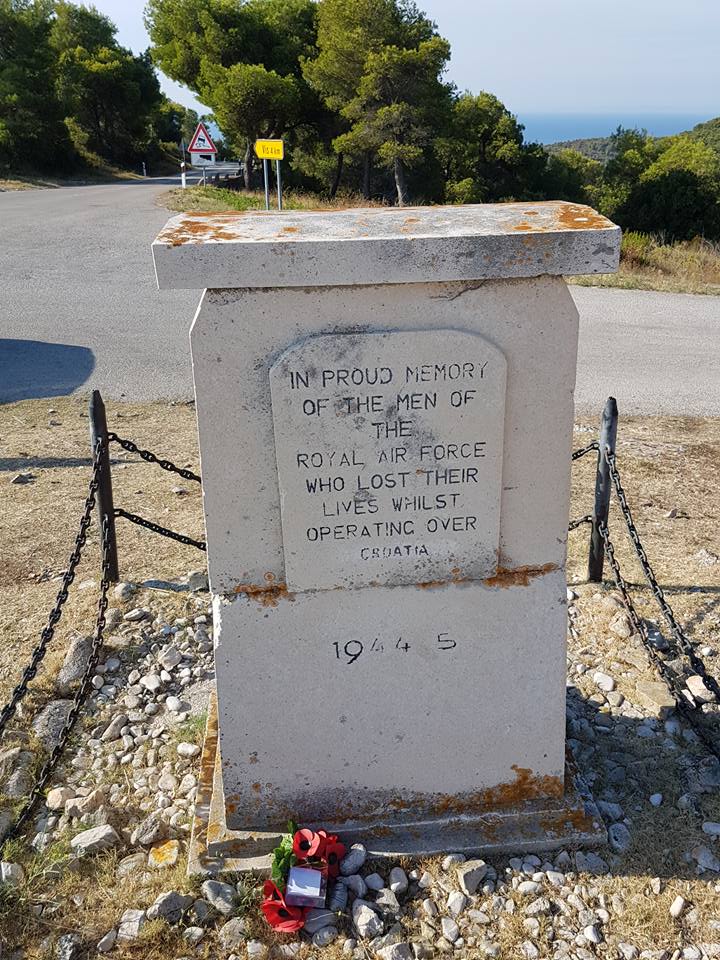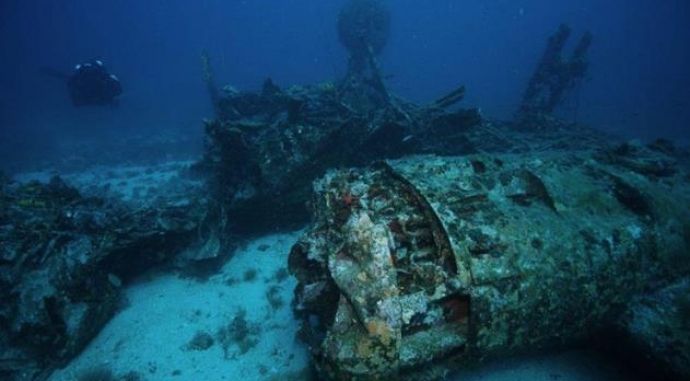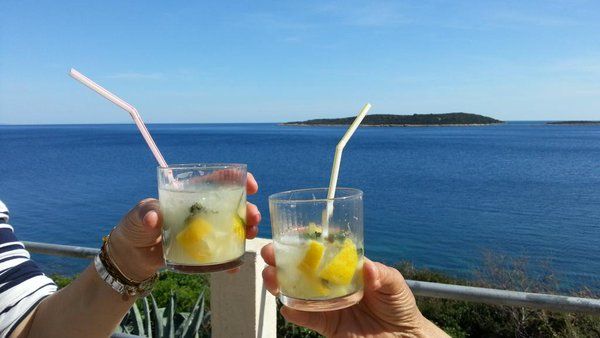Continuing our popular series 25 Things to Know about Croatia on September 18, 2016, one of the most intriguing islands of them all - Vis.
1. Oldest town in Croatia

(Photo credit http://vis-central.com/wp-content/uploads/2012/05/iskopine-anticke-isse-7.jpg)
Stari Grad on the island of Hvar may well be celebrating its 2400-year anniversary since its founding by the Ancient Greeks in 384 BC, with many claiming it to be the oldest town in all Croatia, but the people of Vis will tell you that they hold that title by a few years with the founding of Issa, a colony founded by the Dorians from Syracuse in the 4th Century AD. Whatever the truth, it was the start of a fascinating history of colonisation and foreign visitors to this strikingly beautiful island, one which has fascinated its visitors over the centuries, and whose visits have left an indelible mark on the island's heritage and landscapes. The Greeks had their own money, laws and strict controls on urban development is Issa, and remnants of the fortifications can be visited today.
2. Oldest regatta in the world

(Photo credit http://gajetafalkusa.com/ribarska-prica-palagruza)
As one would expect on an island, much of Vis' fortunes is tied to the sea, perhaps a little more given its location and distance from the mainland - even today, the car ferry from Split takes 3 hours, the catamaran 90 minutes, reassuringly distant to ensure the island is not overrun by tourists. The island's relationship with the sea has led to some rather unusual claims in history, such as it being home to the oldest regatta in Europe if not the world, dating all the way back to 1593, as explained by Croatia.org:
The earliest known description of a sporting event in Croatia is from the 16th century. It reffered to the 1593 regatta of seventy four (yes, 74) wooden fishing boats called falkuša, from the harbour of the town of Komiža on the island of Vis to the islet of Palagruža.
3. Closed island until 1991

As we shall see below, the location of Vis as the furthermost 'main' island in the Adriatic meant that it was a place of strategic importance for regimes and invaders over the centuries. During the period of ex-Yugloslavia, it was a closed island, meaning that it was off-limits to all foreigners, although domestic tourism did exist. With the creation of the modern Croatian state in 1991, Vis was once again open for business, and my favourite story of the period comes from my business bank manager here on Hvar, who was sent by his bank to open a branch on Vis shortly after the island was 'opened'. According to him, there was tremendous suspicion for the first few days, but then people started to come in slowly and deposit their savings, which they had been keeping in their mattresses and other such hiding places. By the end of the month, the bank had taken some 20 million Deutschemarks in deposits! The closed nature of the island obviously affected tourism incomes at the time, but it can be fairly argued that it has stopped Vis becoming over-developed as a destination, which has helped it retain its considerable charm today. Indeed, there are only 3,000 tourism beds on the whole island, a tiny amount compared to neighbouring Hvar.
4. Submarine parking

There are several clear marks of the military past when Vis was closed to the outside world. Tito made it a strategic base for his navy, and even went as far as to build a submarine base deep into a hill close to Vis Town, so that it could not be visible from the air. The base, an impressive 110m long, is open for visitors today, and with the right guide makes for a perfect entrance to Vis if arriving by speedboat. Here is our entrance earlier this year. The base is completely open, and some visitors report on the great acoustics inside... Other submarine bases included the island of Komiza and Sibenik.
5. British heritage

If there is one country which has been consistently associated with Vis over the centruries, it is the Brits. British influence is everywhere on the island, from some of its named fortresses, such as Fort St. George, which has now been turned into a luxury night spot and exclusive dining venue, to Allied cemeteries and even dedicated park benches to those who gave their lives when Vis became the launching point for the invasion of Yugoslavia during World War II. But the British heritage goes back further, and includes the island's rather unusual sporting claim to fame (see below), and continues today, with the latest British invasion, as many British property buyers chose the tranquility of Vis during the property boom of 2004.
6. Military tour

With such a strong military heritage, it is perhaps not surprising that the enterprising tourist agencies have latched on to the idea of offering unusual tours, and the Vis Military Tour is a must do when on the island. What at first seems a peaceful and relaxed island (and it is) does house a truly fascinating past, with warrens of tunnels and bedrooms deep in the hills connecting the numerous gun turrets dug into the mountainside and protecting the island, and innocuous stone houses with no doors masking air vents for weapon loading facilities down below. One of the best tours is offered by Alter Natura, and summarised thus:
"Departure from Komiža or Vis with Land Rover jeeps, after a 20-minute drive we will reach cape Stupišće where a former cannon and rocket base is located. We will pass through the labyrinth of underground tunnels, see the remains of cannons and abandoned warehouses. After a tour of the rocket base Stupišće, we will continue driving to the the highest point of the island of Vis – point Hum 587. We will enjoy the view of the surrounding archipelago and town of Komiža and visit the small church St.Duh. In the return, we will take a tour of the well-known Tito’s cave and hear all about the most significant historical events that have played here. Off road drive to former atomic missile command ARK Vela glava. A tour of the tunnel, return to Komiza." For more info, click here.
7. Oldest cricket in Europe

A little like the submarine base, just when you least expect it, Vis will constantly surprise. Where else, for example, would you expect to find the oldest cricket club in Europe outside the UK, which recently celebrated its 200th anniversary! Remarkable as it sounds, the tale is indeed true, one more example of British influence over the years. The very active Vis Cricket Club tells the story the best, of course, in between hosting cricket matches and annual tournaments on its cricket pitch next to the air strip which played a crucial part in the island's recent history:
"Captain William Hoste was a former shipboy of Lord Nelson himself, a distinguished naval commander who was on his way to a knighthood and was rather more used to sinking Napoleon's warships than guarding a small island in the Mediterranean (around 200 ships were captured or resting at the bottom of the sea on his account). His six-year posting on Vis was not entirely to his liking - after all, it was hot, isolated and Englishmen of his time were never terribly comfortable away from home; it was 1809, and air-conditioning, ice-cream, the aqualung and sun-lotion were all discoveries that lay many years into the future. Instead, they turned to that most English of pastimes - cricket!" Read more on the Vis Cricket Club website.
8. El Shatt
Vis too was to play a pivotal role in one of the more unusual journeys of World War II - the evacuation by the British of some 25,000 Dalmatian civilians to a refugee camp in the Sinai desert in Egypt from 1944-46, as the Germans advanced. With its geographical position, Vis was the departure point for the refugees, who also came from the mainland and other islands such as Hvar, before being shipped to Bari and then on to their new temporary home. It is a fascinating story, not much written about in English - I made a start some years ago here - and there were births, deaths and marriages in the Egyptian desert, with one man on Hvar taking his first name, Sinaj, from the place of his birth. Most families on the island will have some connection to this unusual part of Vis history. Check out some images in the Vis Museum above, and this great BBC report on the return of the refugees to their homeland below.
9. Vis Airport

Vis does have an airstrip, a delightful grassy affair, which today is not in use (although that is due to change next year, as some enterprising locals are planning to open a sports airfield, and are currently going through the paperwork) but it sits nicely next to the island's cricket pitch, but back in the day, the airport on Vis played a crucial role in the Allied campaign for the invasion of Yugoslavia.
Vis was the first island to come under Allied control, and it was used as a launch pad for the invasion. The use of the airport was crucial to not only shorten bombing missions which had been hitherto coordinated from Italy, but also as an emergency landing spot for Allied planes in trouble, as this excellent video below shows (you may have to open in YouTube proper to view).
10. Host Island

(Photo credit Romulic and Stojcic)
British heritage on Vis hs also been left in the names, most notably in the various fortresses all over the island, but also in a charming little island in front of Vis Town, where you can say in your very own lighthouse. Its name? Host Island, named after our cricket-loving Admiral some two centuries ago, although with a slightly different spelling. It is a divine spot.
11. The Battle of Vis (Lissa) 1811 and 1866

That man Hoste again makes his third entry in this Vis 25 compilation, for the island put its name to two decisive battles in European history, one in 1811 and one in 1866:
The French invasion force under Bernard Dubourdieu was met by Captain William Hoste and his four ships based on the island. In the subsequent battle, Hoste sank the French flagship, captured two others, and scattered the remainder of the Franco-Venetian squadron. The battle has been hailed as an important British victory, due to both the disparity between the forces and the signal raised by Hoste, a former subordinate of Horatio Nelson. Hoste had raised the message "Remember Nelson" as the French bore down, and had then manoeuvred to drive Dubourdieu's flagship ashore and scatter his squadron in what has been described as "one of the most brilliant naval achievements of the war".
And then in 1866 the Battle of Vis was a decisive victory for an outnumbered Austrian Empire force over a numerically superior Italian force. It was the first major sea battle between ironclads and one of the last to involve deliberate ramming.
The Italian navy fired roughly 1450 shots during the engagement, but failed to do any serious damage to any Austrian ship while losing two battleships. One of the main reasons for this poor performance was internal rivalry between the Italian fleet commanders: for example, Italian Vice Admiral Albini, with his ships, did not engage the enemy during the battle. The engagement was made up of several small battles: the main battle was between seven Austrian and four Italian ironclads and showed the ability of Austrian commander Tegetthoff to divide his more numerous opponents and then destroy the isolated ironclads. Source for both - Wikipedia.
12. Downed WWII bombers

Just as the island's military past has left its mark on the island and its tourism, so too in the surrounding Adriatic. War brings casualties, and there were no shortage of downed warplanes and bombers in the waters around the island. And with the war long finished, a tourism opportunity, and a scuba diving dream, exploring old wrecks on the bed of the Adriatic. And the discoveries keep on coming, as TCN reported earlier this year.
13. Best beach in Europe

(Photo credit Sugaman Tours)
Enough military history and heritage! Modern Vis is GORGEOUS! And with something for everyone, the main attraction for many on a Dalmatian holiday is beach time. And Vis has that in abundance, offering some of the finest beaches on the coast. Indeed, some would say the island possesses the very best beach in all Europe. Already named at the number one attraction on Vis, travel website European Best Destinations readers voted Stiniva as the best beach in all Europe earlier this year.
14. Blue and Green Cave

(Photo credit Romulic and Stojcic)
The natural treasures of Vis extend to Bisevo close by which is home to one of Croatia's hottest attractions these days, the Blue Cave. The unusual phenomenon, a cave whose water is a deep and luminous blue due to a crack at its top which allows in sunlight, has really been discovered in recent years, and where once day trips only went from Vis, now they also go from Hvar, Brac, Split and beyond, leading to larger traffic than this quiet piece of paradise is perhaps used to. The combination of the Blue and Green Cave, with a swim in Europe's top beach is a fantastic day out. Check out the tour below from Split:
15. Dragodid village
But inland Vis holds its charms too, and none perhaps more so than the small village of Dragodid, which is now part of a great restoration project with European recognition:
Dragodid is a village consisting of only a few houses in the northwest part of the island of Vis, about a fifty minutes’ walk from town Komiža. There is no electricity or running water in Dragodid.
The village is founded by farmers’ family Suić at the beginning of the 19 century. The village grew with the family since the second half of the 20 century when it was abandoned. Nevertheless, it’s still occasionally inhabited: some parts of vineyard are still being cultivated by Suić family and other heirs living in Komiža, and rosemary is still seasonally harvested in the hills nearby. From time to time, hikers from Komiža climb up to Dragodid for a lunch, bowling and to watch rare Eleonora’s Falcon (Falco eleonorae).
Despite some slight but interesting specifics in architecture and organisation, Dragodid’s stone houses and minimal life commodity make it similar to hundreds of villages all along Croatian coast and islands. Most of these villages, as well as Dragodid, were suddenly deserted during the fifties of the 20 century, but today they coming to live again because of tourism.
Since 2002., construction activities came alive in Dragodid, thanks to the cooperation of Andrija Suić (78), one of the sporadic inhabitants of the village with a group of young architects, historians etc., who, from time to time, hold construction workshops in Dragodid. Learn more here.
16. Vugava

And Vis is an island of wine. Like most Dalmatian islands, before the arrival of phlloxera and the punitive Austro-Hungarian wine taxes of the 19th century which led to mass emigration, the fields of Vis were covered in vines. Today, wine production is still an important part of the island's economy, with Plavac Mali the most prominent red variety, and with Vis having its very own indigenous white wine variety, Vugava. My colleague, Iva Tatic, recently wrote an overview of this delightful grape variety, which you can read here. There are about half a dozen serious wine producers on Vis, many of which can be visited on an organised tour.
17. Vis Pie

As well as it own grape variety, Vis has its very own signature dish, which is called Viška pogača, or Vis pie. Given the island's fishing heritage, it is perhaps not surprising that there is a sardine or two involved... According to Dubrovnik Excursion, this is what you need:
DOUGH:
1 kg (2 lb) flour
60 g (2 oz) yeast
2 Tbsp salt
1 Tbsp mixed mediterranean herbs (rosemary, thyme, basil)
2 Tbsp olive oil
water
FILLING:
500 g (1 lb) onions, chopped
500 g (1 lb) tomatoes, peeled and chopped
250 g (0.5 lb) anchovies, cut in pieces
100 g (3.5 oz) capers
100 g (3.5 oz) olives, seeded
100 ml (4 fl oz; 1/2 cup) olive oil
salt, black pepper.
Click here for the cooking instructions.
18. Lemons of Vis

The Mediterranean diet is of course an extremely healthy one, and one which which came under UNESCO protection in 2013, and the fields of Vis are a delight to visit to check out the freshest, wholesome produce. No 24-7 supermarkets here, just the very best homegrown food, available straight from the tree. Nothing symbolises this perhaps more than the lemons of Vis, reckoned to be the very best in all Croatia, and perhaps a clue as to why the British love this island - a slice of Vis lemon can only enhance the very best gin and tonic!
19. Fishing tradition – lobster

Fishing is obviously has obviously been a key industry over the centuries on Vis, and nowhere more so than the island's second town of Komiza, which back in its heyday had no less than seven fish factories in operation, a remarkable number for such a small community. While fishing remains important today, the major fishing industry is seriously diminished, with just one of the seven factories still in existence, and that in name only, after a recent purchase from a South African, a purchase one suspects for the real estate, as the processing equipment has long been sold. The fish on the island is still excellent, and Komiza remains one of the go to places on the Adriatic for lobster.
20. Mediterranean Monk seals

One of the challenges facing the Komiza fishermen over the centuries has been the unwelcome attention from the Mediterranean monk seals, which has been sharing the waters with the lobster and other delicious catch. The monk seals, which used to be prevalent in the waters around Vis (indeed there is a 'monk seal cave' on Bisevo where they used to inhabit) are close to dying out these days, and they are an endangered species. While sightings do still occur, it is estimated that there are less than 350 left in the whole Adriatic.
21. More families making money from fishing than tourism

(Photo credit Romulic and Stojcic)
Here is a statistic which surprised me on my recent visit, but sums up a little of the effects of Vis' peculiar history. Komiza is one of the most beautiful of all Dalmatian towns, in an ideal setting, perfect for tourism. It has a strong fishing tradition as mentioned above, and it has 'suffered' from tourism development from the island being closed to foreigners since 1991. And yet, some 25 years later, with Croatia one of the European buzz words for cool tourism, and almost every visitor to Vis waxing lyrical about this hidden gem, today there are more families in Komiza making a living from fishing than from tourism. Refreshing.
22. Oldest brothel on Dalmatian islands

(Photo credit Romulic and Stojcic)
This is one I need to research a little more, as the subject is not one of my specialist subjects, but I have heard it from numerous sources. A century ago, Komiza was booming, with a population not that different to population centres such as Split, all powered by the fishing industry and those seven fish factories. The population in Komiza was bigger than the population of the island today, and that led to entertainment opportunities. A century ago, Komiza had not one, but two brothels, supposedly the first on the islands of Dalmatia. Anyone with more info, please contact me, and I can update this section.
23. Craft beer from Norway

What else to expect from an island that gave cricket to mainland Europe than the first craft beer in Dalmatia to be made in... Norway! Incredible but true, and the story is cute. Two Norwegian enthusiasts who have been visiting the island every year for almost 20 years came up with the idea to open a craft beer making facility on Vis. All was going well until they hit the legendary Croatian bureaucracy, and they were not able to proceed as planned. Rather than give up on the plan, which should start in 2017, they decided to go ahead with their beer production, producing this year's beer in Norway and shipping it to Vis. A little bizarre? For sure, but this is Vis, where things are done a little differently. And very nice the beer is too!
24. Eleonora's falcon

Vis is also of interest to birdwatchers hoping to catch a glimpse of the rare Eleonora's falcon, as Croatia Birding explains:
Island of Vis and the smaller islands around it, as well as islands of Bisevo, St. Andrija, Brusnik, Jabuka and Palagruza, are the only nesting area of Eleonora's Falcon in Croatia, while the almost entire national breeding population of Cory's Shearwater also dwells here. For these two species the most important is the Island of St. Andrija with the nearby islet of Kamnik. They are nesting on cliffs and rocks rising sheer from the sea.
25. Falkusa

And where to finish, but on the sea, and a traditional fishing boat from Vis, which made the island famous and was responsible for that very first regatta, described by others better than me:
A falkuša is a traditional fishing boat used by fishermen from the town of Komiža on the Adriatic island of Vis, Croatia. Falkuša is a subtype of gajeta, a traditional Dalmatian fishing sailboat, and is sometimes called gajeta falkuša. Its design was adapted to specific needs of Komiža fishermen, who went to long fishing expeditions in the open seas, a unique practice in the Adriatic and Mediterranean.
The Falkuša is a unique wooden boat, tapered narrowly on both sides, and is about seven to eight metres in length by 3 metres wide. It had a low draft under a large (120 m2 or 1,300 sq ft) lateen sail made from flax, mounted on a mast which was typically as high as the ship was long. It was very fast both under sail and with oar, able to achieve speeds between 8 and 12 knots. Its distinctive feature were two removable wooden side strakes called falke, after which falkuša got its name. The strakes raised the rim of the boat by about half a metre, protecting it from high waves in the open seas. To ease the hauling of the nets, the strakes were removed during fishing. The vessel could carry up to eight tonnes of salted fish barrels.
For its characteristics of toughness and strength, the traditional gajeta falkuša was made only with cypress wood from the volcanic island of Svetac. The keel was made of oak and the shell of larch. A typical falkuša carried a crew of six men. There were five oars for standing oarsmen which were 7 to 9 meters in length. The fishermen used nets and a feral, a gas or petroleum lamp for attracting fish. Fishing trips lasted 20 to 25 days, to make them financially viable. Duties such as cooking, washing, repairing, sailing between fishing posts and dealing with bad weather left only 10 to 12 days for actual fishing in a typical journey.
Visit Vis, it is a fabulous island!


